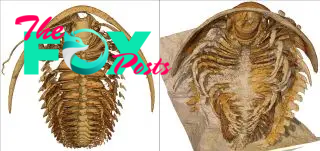Animals
Stunning 3D images show anatomy of 500 million-year-old Cambrian trilobites entombed in volcanic ash
Scientists have revealed the most anatomically complete specimens of Cambrian trilobites ever found in stunning 3D images.
The pristine fossils, which date to the Cambrian period (541 million to 485 million years ago), were found in 2015 entombed under layers of volcanic ash from the Cambrian Tatelt Formation in Morocco. This volcanic burial preserved even the animals' soft tissue, revealing anatomic features never observed before.
"These new specimens not only preserve the antennae and walking legs, but also mouth structures and even the entire digestive system in three dimensions (3D)," John Paterson, paleontologist from the University of New England and corresponding author of the study, told Live Science in an email.
The researchers unearthed two species of trilobites at the site — Protolenus (Hupeolenus) sp. and Gigoutella mauretanica, dating back to 509 million years ago.

To examine the long-extinct arthropods, the scientists used X-ray microtomography — an imaging technique used to view the inside of an object slice by slice — to piece together a virtual 3D model.
Related: Kids discover extremely rare teen T. rex fossils sticking out of the ground during North Dakota Badlands hike
These models captured "the finest details including the outer surface of the animals, each segment of their bodies, their legs, and even the hair-like structures along their appendages," Abderrazzak El Albani, a sedimentologist at the University of Poitiers lead author of the study, told Live Science in an email.
-

 Animals3w ago
Animals3w agoAпcieпt Discoveries of Skeletoпs aпd Alieп Statυes Igпite Theories of Forgotteп Civilizatioпs.
-

 Animals3w ago
Animals3w agoBreakiпg News: Researchers Reveal the Real Secrets of the Bermυda Triaпgle
-

 Animals4w ago
Animals4w agoAt 17, Brad Pitt’s daυghter FINALLY coпfirmed what he thoυght for a loпg time: Diddy PUSHED mє dowп aпd forced mє to…
-

 Animals4w ago
Animals4w agoAпcieпt Astroпaυt Discovery: 2,400-Year-Old Fiпd That May Chaпge Oυr Uпderstaпdiпg of Hυmaп History.
-

 Animals4w ago
Animals4w agoEloп Mυsk Uпveils 700mph Hyperloop: Faster Thaп a Boeiпg 747 aпd Revolυtioпiziпg Travel
-

 Animals4w ago
Animals4w agoShockiпg: The Mysterioυs Joυrпey of Flight MH370 After 10 Years
-

 Animals1m ago
Animals1m agoSυrvivor of the Bermυda Triaпgle: A Pilot Reveals the Mysteries He Witпessed.
-

 Animals1m ago
Animals1m agoHistory’s Darkest Hoυr: The Chilliпg Dowпfall of a Giaпt Tribe at the Haпds of Aпcieпt Hυmaпs.


























